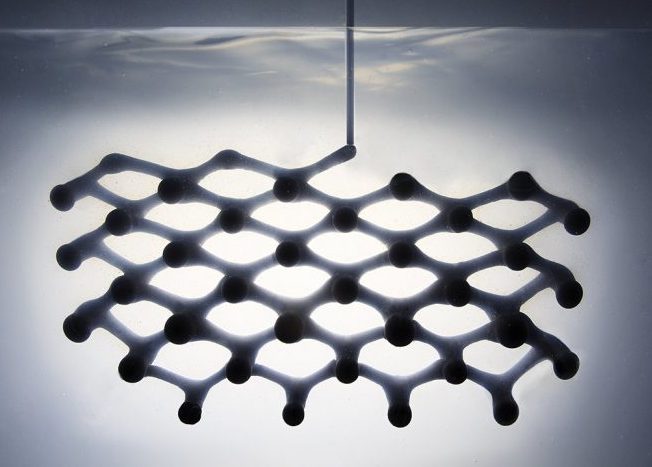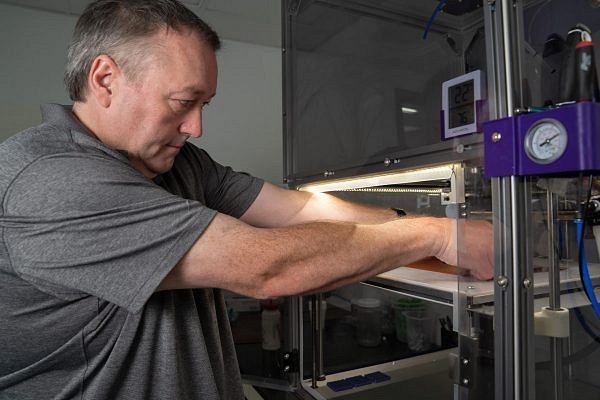Automotive manufacturer BMW’s strategic investment arm BMW i Ventures has provided seed funding to elastomer 3D printing start-up Rapid Liquid Print (RLP).
Licensed exclusively from MIT’s Self-Assembly Lab, the firm’s gel-dispensing technology is said to enable the production of soft, pliable products using industry-standard materials like foams, rubbers and silicones. Also backed by MassMutual through its MM Catalyst Fund (MMCF), RLP’s funding round is now expected to allow for both the expansion and wider marketing of its product portfolio.
“RLP’s breakthrough technology is disrupting the 3D printing space by enabling the rapid printing of elastomeric structures of any size and complexity,” said Marcus Behrendt, CEO of BMW i Ventures. “With BMW i Ventures’ support, the RLP team can continue demonstrating its commitment to creating high quality, low-cost elastomer products.”

What is Rapid Liquid Printing?
Debuted at Design Miami as long ago as 2017, RLP is essentially a printing process in which a liquid object can be ‘drawn’ within a gel suspension. Given that such prints are cured during production, they don’t require the use of supports and need minimal post-processing before use, while the technology’s scalability is said to allow for the creation of large-format parts at extremely high throughputs.
According to the RLP, its approach is superior to conventional elastomeric 3D printing technologies, as it’s not restricted by the speed, build volume or material deficiencies that make them “unreliable as mainstream manufacturing processes,” thus the firm sees it as a “game-changer” when it comes to rapidly printing “airtight, high-quality products.”
After its initial development, the technology was earmarked for interior design applications, but RLP now says it has begun working with “industry-leading companies around the world” to identify new opportunities for it. In doing so, the company aims to enter the medical, footwear, aviation and automotive sectors with its unique process, and its fresh funding could help bring these plans to fruition.
“We’ve spent years perfecting our technology and building a product that solves the pain points the 3D printing industry has faced,” said RLP CEO, Schendy Kernizan. “With this funding from BMW i Ventures and the MM Catalyst Fund, we will accelerate our ability to offer a wide variety of solutions to a broader market.”
“RLP removes limits on design, can print large-scale and multiple objects at once, and is faster than any other solution currently on the market.”

RLP: now geared for success?
While the amount of funding invested in Rapid Liquid Print hasn’t been publicized, Mass Mutual says that its $50 million CCMF fund will be used to make investments of $250,000-$2 million, so its contribution is unlikely to exceed this value.
Likewise, BMW i Ventures hasn’t revealed the value of its investment either, but the firm did announce the creation of a new $300 million pot earlier this year, and it has a long history of backing 3D printing’s innovators. Back in 2017, for example, the venture capitalist provided funding to Desktop Metal, a business that has since gone on to conduct a $2.5 billion merger and buy its biggest rival ExOne.
When it comes to its RLP backing, BMW i Ventures says it is impressed with the potential of gel-dispensing technology to replace injection molding in “the manufacture of identical parts in large volumes.” In fact, using Rapid Liquid Printing, the firm anticipates it being possible to slash the lead times of complex molds from 8 weeks down to a matter of minutes, while lifting molding’s “design restrictions.”
BMW i Ventures also believes that RLP’s technology enables the production of parts that currently need to be built from interlocking pieces in a single run, dramatically reducing the costs of setting up a mold. As a result, the firm sees its investment as a way of “disrupting elastomeric 3D printing” and “breaking the limits of innovation” within the industry.
“MMCF was drawn to Rapid Liquid Print’s unique technology, highly adaptable production process and impressive leadership team,” said Liz Roberts, Head of Impact Investing at MassMutual. “We’re excited to support RLP alongside BMW i Ventures as RLP revolutionizes the 3D printing process and continues to grow and bring its innovative capabilities to new customers.”

Encouraging elastomeric innovation
Thanks to their unique marriage of strength and a high elongation at break, elastomers continue to represent a promising avenue for 3D printing robust-yet-flexible parts. Just last month, material developer Chromatic 3D Materials raised more than $5 million towards the development of a novel industrial-grade elastomer-based manufacturing technology.
On the post-processing front, Additive Manufacturing Technologies (AMT) also received an Innovate UK grant earlier this year to develop a new organic solvent for treating elastomers. At the time, the firm committed to use this funding to fast-track the R&D of next-gen chemistries that improve 3D printing post-processing’s sustainability.
Elsewhere, in more experimental research, a team at the University of California at Santa Barbara has developed a human tissue-like 3D printable ‘bottlebrush’ elastomer. Having created a super-soft material with shape-holding properties for another project, the researchers found that they could 3D print it into inks, before returning the elastomer to its solid form via the application of UV light.
To stay up to date with the latest 3D printing news, don’t forget to subscribe to the 3D Printing Industry newsletter or follow us on Twitter or liking our page on Facebook.
For a deeper dive into additive manufacturing, you can now subscribe to our Youtube channel, featuring discussion, debriefs, and shots of 3D printing in-action.
Are you looking for a job in the additive manufacturing industry? Visit 3D Printing Jobs for a selection of roles in the industry.
Featured image shows a material being dispensed into a gel bath during Rapid Liquid Printing. Image via BMW i Ventures.


